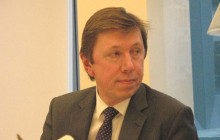In July 2014 Ukraine will be able to receive the first molecules of liquefied gas. State Investment Agency Chairman Vladyslav Kaskiv promised that an LNG terminal would be established in the middle of the next year. Incidentally, this project has been repeatedly subjected to scathing criticism in the three years of its existence (Natsproekt LNG Terminal, the company in charge of building a liquefied natural gas terminal on the Black Sea coast, was set up on December 17, 2010). Two months ago (February 26) experts of the Oxford Institute for Energy Studies even called this project “prohibitively expensive” for Ukraine. The institute’s Senior Research Fellow Simon Pirani said at the Fourth Energy Forum in Kyiv that this project was unviable because it is still uncertain whether liquefied gas tankers will be able to pass the Turkey-controlled Bosporus and Dardanelles straits. What seemed to be a true epic fail last year was a juicy scandal about signing a contract with the Spanish company Gas Natural Fenosa on the construction of an LNG terminal. Yet the project continues to be funded from the state treasury and is considered an integral part of this country’s development strategy. Incidentally, while consultants are calling the project “unviable,” real European business regrets that it failed to win the bid. The overall picture is as follows.
What a group of Ukrainian journalists consider as one of the most interesting contacts in France was a visit to the international public limited company Technip. Once commissioned in France and Italy, the company has offices today in such Eastern European cities as Warsaw (Poland) and Sarajevo (Bosnia and Herzegovina) as well as in Athens (Greece). It employs 35,000 people all over the world. Technip manages oil and gas projects, such as installation of the equipment, construction of gas-processing plants, and laying land and marine gas pipelines. “We deliver hydrocarbons to the placers of consumption and processing. We carry out turnkey projects, which includes drawing up feasibility reports and engineering development programs,” Philip Hagyard, Senior Vice President of LNG/GTL Business Unit at Technip, said to the Ukrainian journalists. “We commission an enterprise on what is known as turnkey basis. To do so, we purchase services and equipment throughout the world. Technip’s operational fleet consists of 33 vessels that help mount marine, including underwater, structures and gas pipelines. The company has a high level of capitalization. Incidentally, this includes not only the ratio of high-cost and high-efficiency equipment, but also the skill of the engineering personnel. The first and foremost value of Technip is its personnel.”
Why do you still have no office in Ukraine, Europe’s largest gas consumer, and did your company take part in bidding for such a Ukrainian project as LNG terminal?
“The history of our interest in Ukraine began almost 50 years ago, in 1965. We actively cooperated with such Ukrainian companies as Ukrtransnafta, and Kherson and Kremenchuk refineries. In 2009 we drew up a project proposal for increasing the quality of Kremenchuk products. But, unfortunately, all our contacts with Ukrainian partners have so far been limited to proposals. There are many causes of this. But I personally continue to work in this direction today. We are greatly interested in Ukraine’s energy sector. Answering your second question about an LNG terminal, I can say that we took part in the bidding for this terminal. This was a very good contact, as far as our business prospects in Ukraine are concerned, but, unfortunately, we failed to win this bid. Yet we continue to be in touch with the National Group in charge of this project.”
Were the bids invited for a feasibility report or for construction?
“At the first stage, we took part in the bidding for a feasibility report, and now they have invited bids for some second-stage services. We had the latest contact with the National Project task force last week – in other words, we maintain regular contacts.” (The journalists were shown photographs of a Technip-built LNG terminal in Texas, USA, and told that Technip would like to take part in the dredging stage of the LNG terminal construction and then deal with re-gasification only.)
Are you going to supply the floating re-gasification plant to Ukraine at the first stage, as the feasibility report calls for? Or will another company deal with this?
“This projects calls for stage-by-stage construction. The final objective is to build a plant or an onshore gasification platform, that is, a land-based coastal facility. Yet the bidding procedure has three stages. The first is buying a floating re-gasification platform, the second is concluding contracts with liquefied gas suppliers, and the third is creating conditions for land-based stationary re-gasification. We do not think, however, that buying a floating plant is advisable. One must build an onshore facility straightaway.”
And what is your attitude to changes in the Ukrainian government’s plans, of which our Prime Minister Mykola Azarov said recently? It is not ruled out that the Ukrainian LNG terminal will be built in Turkey or even, reportedly, somewhere in former Yugoslavia.
“It seems to me that Ukraine has not yet shaped a clear and unambiguous policy in this matter. This is not conducive to the success of our negotiation in Kyiv.”
What can you say about the last round of these negotiations? What was the result? Do you think the further talks will be productive for both sides?
“As I have already said, Technip took part in the bidding’s second phase for the LNG terminal’s feasibility report, but the company failed to win in this part of the competition. We continue to be in touch with the National Project Group and confirm our interest in the development of the Ukrainian LNG terminal project. Technip also intends to take part in the further phases of the bidding procedure once they have been called.”







